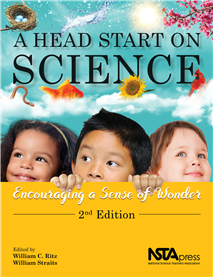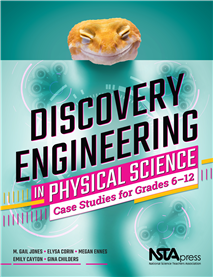All Book Chapters
Book Chapter
This activity is for finding out how drops of different liquids behave. Give the children each a piece of waxed paper and ask them to try dropping a small amount of water onto their paper in order to make drops. Ask children to describe what they fou...
Book Chapter
This activity is for finding out what happens when materials stay in water for a long time. Give children an egg carton and let them put water in each compartment. Then choose different items for each compartment and predict which items will change. ...
Book Chapter
This activity is for making and testing different bubble makers. Put out materials listed and ask children how they could use the materials to create a bubble maker. Children love making bubbles! They will test all the materials you make available. E...
Book Chapter
This activity is for making things with sand and water. At a sand table or in a sandbox, let the children begin by exploring dry sand and then add water to the sand. Wet sand allows children to try out many more ideas than dry sand does. Encourage th...
Book Chapter
This activity is for mixing two primary colors to create a secondary color. When introducing mixing of colors, always start with the primary colors and choose only two. Point out the different shades that children are producing as they use more of on...
Book Chapter
This activity is for dipping paper towels and other materials in colored water to make designs and test absorption properties. Give children paper towels and encourage them to fold any way they want, and then to dip corners or sections into the diffe...
Book Chapter
This activity is for dropping water on a semi-absorbent surface to see what happens. Children can work in pairs with one dropping colored water from an eyedropper into a box, and the other one tilting the box to see what happens to the water. When ...
Book Chapter
This activity involves mixing water with cornstarch and exploring the result. Have children measure two cups of cornstarch and one cup of water into their bowls. Then have them compare oobleck, water, and cornstarch and describe how each feels and lo...
Book Chapter
This activity involves observing properties of a new material. Away from children, make a batch of snappy with recipe provided and put on table for them to use. Children will work with the snappy for a long time—pushing, pulling, rolling, and stre...
Book Chapter
This activity involves looking for seeds in fruit. Put out fruit for children to see and give them an opportunity to touch and smell each of them. Then cut the fruit and give each one. When one of them uses the word seeds, repeat the word and encoura...
Book Chapter
This activity is for observing seeds in fruits and vegetables. Show the children a small assortment of seeds and ask them what they think the seeds are and where they come from and then discuss their ideas. As a follow-up activity, provide children d...
Book Chapter
This activity is for observing and sorting seeds. Distribute an assortment of seeds to each child. Ask them to put together all the seeds that seem to be the same and encourage them to sort their seeds according to different properties or characteri...
Book Chapter
This activity involves sorting seeds by one attribute. Have sorting boxes ready for each child and distribute one set of seeds to each. Provide children with magnifiers and let them explore their seeds. After their initial exploration, call out a cha...
Book Chapter
This activity is about observing seeds while they absorb water, change size, and become soft. Give a lima bean seed and magnifier to each child and suggest putting it into water. Invite the children to look at their seeds several times during the day...
Book Chapter
This activity is about observing the inside of soaked lima bean seeds. Give each child two presoaked lima beans. Have them loosely wrap the seeds in a moist paper towel and place them on a plastic plate. Allow the children to carefully unwrap their ...
Book Chapter
This activity is about planting a terrarium. Have each child choose a container and a plant and then follow the planting procedure. Place the terrarium where it will get plenty of light and have the children observe and describe their plants regula...
Book Chapter
This activity is about exploring an ear of corn. Encourage children to describe how the cornhusks feel, smell, and look. After a few minutes encourage children to find out what is inside the cornhusks. Then cook the corn so they can taste it. A foll...
Book Chapter
This activity is for investigating how heat changes things. Hand out some unpopped popcorn kernels to the children for observation. Then make some popcorn! This is a science investigation that they can eat so allow children to describe how it tastes...
Book Chapter
This activity is for comparing and grinding fresh and dried corn. Let children handle the dried and fresh corncobs and talk about what they see and feel. Give children time to explore and then put all the dried kernels in one bowl to soak in water ov...
Book Chapter
This activity is for using a variety of seeds to make a collage or wreath. Have the children help you begin saving seeds from fruits and vegetables and also from the plants around the schoolyard. Observe which seeds children seem to be most intereste...
Book Chapter
Pondering Pumpkins: The Outsides
This activity is for investigating the exterior of pumpkins. Select a few pumpkins of different sizes for small groups of children to observe and compare. Give the children time to look at and touch the pumpkins and then challenge them to figure out ...
Book Chapter
Pondering Pumpkins: The Insides
This activity is for investigating the insides of pumpkins. After finding out what children think the insides of pumpkins are like carefully cut the pumpkins in half horizontally around the middle. After their observation, ask the children to share w...
Book Chapter
This activity is about finding interesting objects in nature to make into a bracelet. Give children a bracelet by placing a piece of masking tape around the wrist, sticky side out. Then take a nature walk so they can make “nature bracelets” by pi...
Book Chapter
This activity is about looking for weeds when taking children on a walk. When back in the classroom, have them observe the weeds they pulled and put in their bags. Then have them tape all the weeds together on a big piece of paper to display with a h...
Book Chapter
This activity is about going for a walk to look for animals in the neighborhood. Encourage children to talk about how animals look, how they move, and what they eat and make a list on chart paper of all the animals they remember seeing. As a fun foll...
Book Chapter
This activity is about making observations of a tree over time. Choose a tree that is near the school and one that changes through the year. A deciduous tree—one that loses its leaves—makes the best subject. Visit the tree and repeat this activit...
Book Chapter
This activity is about visiting a nursery to observe plants, flowers, and trees. Encourage them to look for many different colors, shapes, and smells. If possible, bring back plants from the nursery for children to plant at school or to take home. ...
Book Chapter
This activity is about putting pieces of a branch together to make a whole branch. Take the children for a walk and encourage them to observe trees, with focus on the trunk and branches. Then show them the branch puzzles and challenge them to put a p...
Book Chapter
This activity is about exploring the shapes, sizes, and colors of fall leaves. Take the children on a walk to collect leaves and challenge them to find something interesting about the leaves. Back in the classroom, have them sort the leaves in differ...
Book Chapter
This case study deals with how advancements in science and engineering are often unexpected yet lead to valuable applications. In this lesson, students explore a metal that can be bent and, when lightly heated, “remembers” and springs back into i...
Book Chapter
Harnessing the Color of Nature
In this lesson, students explore how certain organisms, including some plant and animal species, display beautiful iridescent colors when light interacts with nanoscale structures on their surfaces. The activity on structural color and iridescence w...
Book Chapter
This case study features a summary of the history of artificial dye. In this lesson, students learn how artificial dye was accidentally discovered and subsequently used in new applications. They examine indicators as a way to test pH levels and a...
Book Chapter
This case study features a summary of how new products were made to mimic shark skin. In this lesson, students will learn about shark skin and bacteria and a product developed to mimic shark skin. They will focus on how this material was developed ...
Book Chapter
This case study features a summary of an adhesive developed using the same principles as those used by gecko feet. In this lesson, students explore Gecko Feet Adhesives. Geckos are able to hang by one toe from a smooth surface and researchers have ...
Book Chapter
This case study contains a summary of a study on seahorse tails. In this lesson, students consider how researchers studied seahorse tails and then they work together to think of new ways in which the structure can be used to solve real-life problem...
Book Chapter
This case study provides a summary of the history of Corn Flakes. In the lesson, students explore the history of Kellogg’s Corn Flakes and the applications of corn-based products that can provide food and energy sources for human consumption. The d...
Book Chapter
Get Fired Up With Friction Lights
This case study provides a summary of the history and science of matches. In the lesson, students consider how matches were discovered and work together to think about new applications for matches to solve real-life problems. Matches, also called f...
Book Chapter
This case study provides a summary of the discovery and history of plastics. Students consider how plastic was discovered and work together to think about new applications for plastic to solve real-life problems. They explore plastics that are not ...
Book Chapter
This case study provides a summary of the invention of Post-It Notes. In this lesson, students learn about the invention which resulted from an accidental discovery that has led to them being a household item. Students also learn about the properti...
Book Chapter
This case study provides a summary of the invention of Silly Putty, along with recipes for students to make toy putty. In this lesson, students explore the unintended discovery of silly putty, as well as non-Newtonian fluids. Students consider how ...




